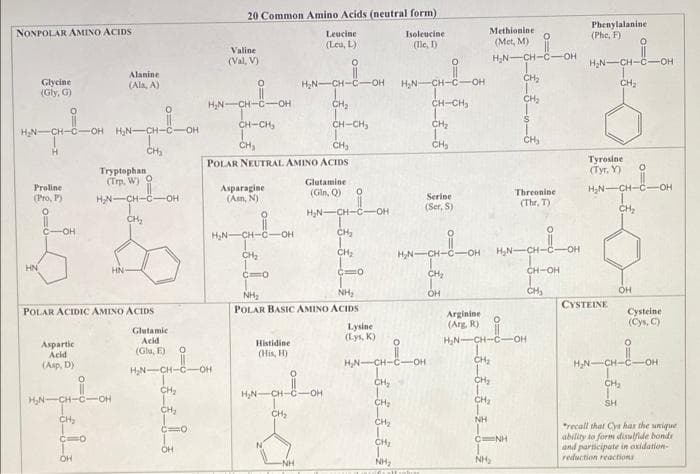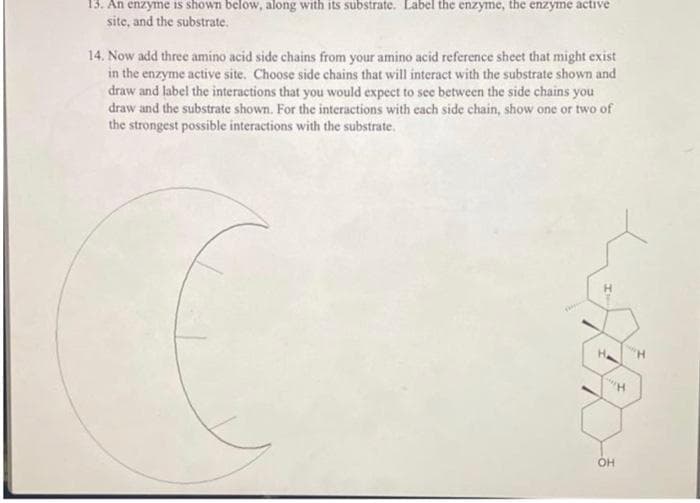13. An enzyme is shown below, along with its substrate. Label the enzyme, the enzyme active site, and the substrate. 14. Now add three amino acid side chains from your amino acid reference sheet that might exist in the enzyme active site. Choose side chains that will interact with the substrate shown and draw and label the interactions that you would expect to see between the side chains you draw and the substrate shown. For the interactions with each side chain, show one or two of the strongest possible interactions with the substrate.
13. An enzyme is shown below, along with its substrate. Label the enzyme, the enzyme active site, and the substrate. 14. Now add three amino acid side chains from your amino acid reference sheet that might exist in the enzyme active site. Choose side chains that will interact with the substrate shown and draw and label the interactions that you would expect to see between the side chains you draw and the substrate shown. For the interactions with each side chain, show one or two of the strongest possible interactions with the substrate.
Introductory Chemistry: A Foundation
9th Edition
ISBN:9781337399425
Author:Steven S. Zumdahl, Donald J. DeCoste
Publisher:Steven S. Zumdahl, Donald J. DeCoste
Chapter21: Biochemistry
Section: Chapter Questions
Problem 28QAP: . Describe the lock-and-key model for enzymes. Why are the shapes of the enzyme and its substrate...
Related questions
Question
100%
3

Transcribed Image Text:20 Common Amino Acids (neutral form)
Methionine
(Met, M)
Phenylalanine
(Phe, F)
NONPOLAR AMINO ACIDS
Leucine
Isoleucine
(Leu, L)
(Ile, I)
Valine
(Val, V)
H,N-CH-C-OH
H;N-CH-C-OH
Alanine
CH;
HN-CH-C
CH-CH,
Glycine
(Gly, G)
CH-C-
OH
(Ala, A)
H2N-
OH
CH2
CH;
HN-CH-C-OH
CH
CH-CH,
CH-CH,
CH
HN-CH-C-OH H,N-CH-C-OH
CH
CH
CH,
CH,
H.
CH
Tyrosine
(Tyr, Y)
POLAR NEUTRAL AMINO ACIDS
Tryptophan
(Trp, W) O
HN-CH-C-OH
Glutamine
Proline
Asрaragine
(Asn, N)
H,N-CH-C-OH
(Gln, Q)
Threonine
(Pro, P)
Serine
(Ser, S)
(The, T)
H,N-CH-C-OH
CH
CH,
C-OH
H,N-CH-C-
OH
CH
CH,
H,N-CH-C-OH
CH2
H,N
CH-
-он
HN
HN
CH-OH
CH
NH,
NH,
OH
CH,
CYSTEINE
POLAR ACIDIC AMINO ACIDS
POLAR BASIC AMINO ACIDS
Cysteine
Arginine
(Arg, R)
(Cys, C)
Glutamie
Acid
Lysine
(Lys, K)
HN-CH-C-OH
Aspartic
Acid
Histidine
(His, H)
(Glu, E)
(Asp, D)
H,N-CH-C-OH
CH,
H,N-CH-C-OH
HN-CH-C
OH
CH,
CH
CH2
H,N-CH-C
H,N-CH-C-
OH
CH
SH
CH,
CH
NH
"recall that Cya har the unique
ability to form diulfide bonds
and participate in oxidation-
reduction reactions
CNH
CH,
OH
NH,
NH2
NH

Transcribed Image Text:13. An enzyme is shown below, along with its substrate. Label the enzyme, the enzyme active
site, and the substrate.
14. Now add three amino acid side chains from your amino acid reference sheet that might exist
in the enzyme active site. Choose side chains that will interact with the substrate shown and
draw and label the interactions that you would expect to see between the side chains you
draw and the substrate shown. For the interactions with each side chain, show one or two of
the strongest possible interactions with the substrate.
Expert Solution
This question has been solved!
Explore an expertly crafted, step-by-step solution for a thorough understanding of key concepts.
This is a popular solution!
Trending now
This is a popular solution!
Step by step
Solved in 2 steps with 1 images

Knowledge Booster
Learn more about
Need a deep-dive on the concept behind this application? Look no further. Learn more about this topic, chemistry and related others by exploring similar questions and additional content below.Recommended textbooks for you

Introductory Chemistry: A Foundation
Chemistry
ISBN:
9781337399425
Author:
Steven S. Zumdahl, Donald J. DeCoste
Publisher:
Cengage Learning

Chemistry for Today: General, Organic, and Bioche…
Chemistry
ISBN:
9781305960060
Author:
Spencer L. Seager, Michael R. Slabaugh, Maren S. Hansen
Publisher:
Cengage Learning

Introductory Chemistry: An Active Learning Approa…
Chemistry
ISBN:
9781305079250
Author:
Mark S. Cracolice, Ed Peters
Publisher:
Cengage Learning

Introductory Chemistry: A Foundation
Chemistry
ISBN:
9781337399425
Author:
Steven S. Zumdahl, Donald J. DeCoste
Publisher:
Cengage Learning

Chemistry for Today: General, Organic, and Bioche…
Chemistry
ISBN:
9781305960060
Author:
Spencer L. Seager, Michael R. Slabaugh, Maren S. Hansen
Publisher:
Cengage Learning

Introductory Chemistry: An Active Learning Approa…
Chemistry
ISBN:
9781305079250
Author:
Mark S. Cracolice, Ed Peters
Publisher:
Cengage Learning

General, Organic, and Biological Chemistry
Chemistry
ISBN:
9781285853918
Author:
H. Stephen Stoker
Publisher:
Cengage Learning

Organic And Biological Chemistry
Chemistry
ISBN:
9781305081079
Author:
STOKER, H. Stephen (howard Stephen)
Publisher:
Cengage Learning,

World of Chemistry, 3rd edition
Chemistry
ISBN:
9781133109655
Author:
Steven S. Zumdahl, Susan L. Zumdahl, Donald J. DeCoste
Publisher:
Brooks / Cole / Cengage Learning